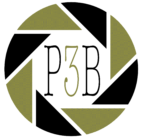- RANGEFINDERS
- VIEWFINDERS
- TYPES OF LENSES
- FILTERS
- DARKROOM EQUIPMENT
- PROJECTORS & VIEWERS
- TRIPODS
- MISCELLANEOUS
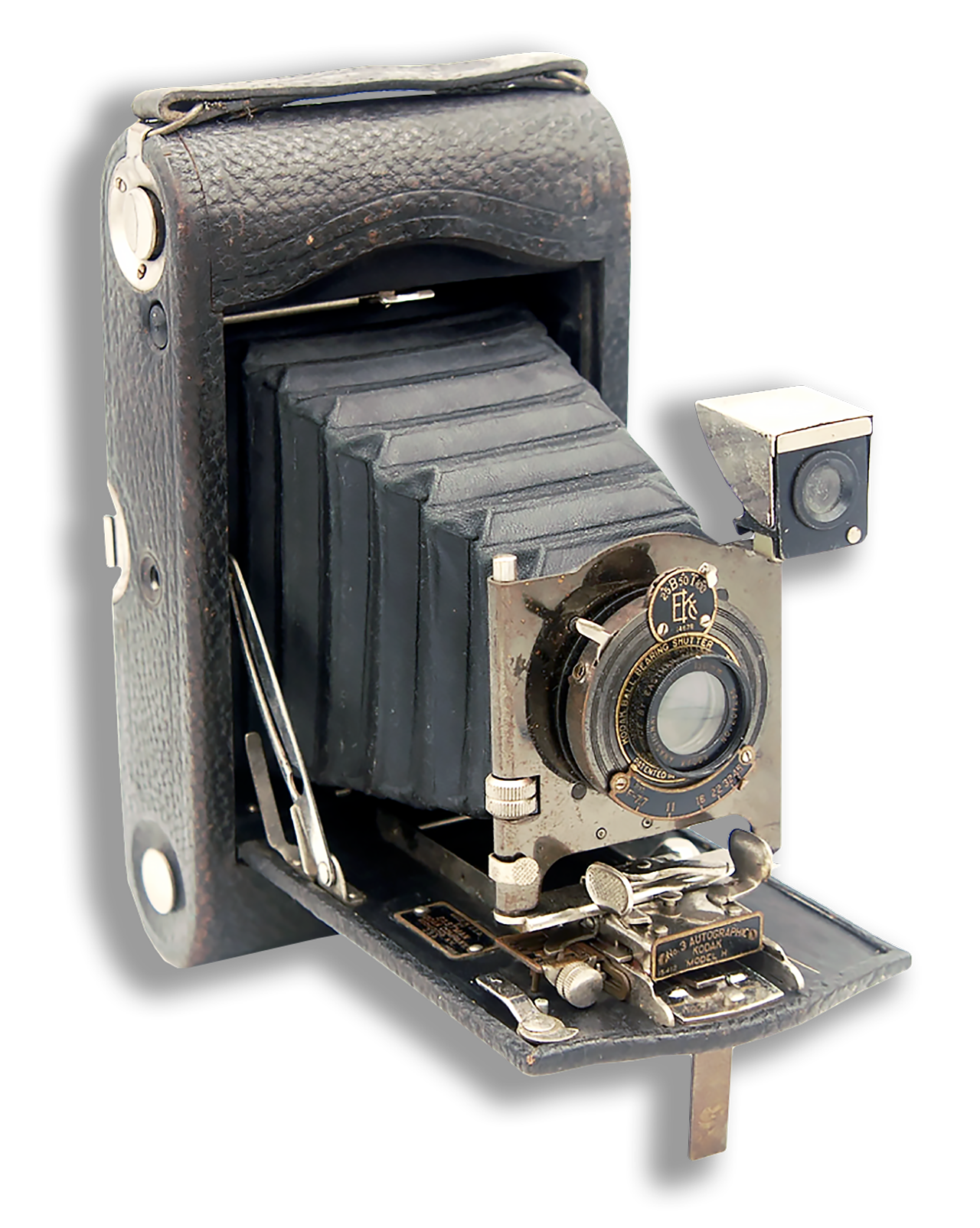
Rangefinders Built into Cameras
The first coupled rangefinder camera was the 3A Autographic Kodak Special of 1916. It works typically with a split-image : a way of focusing precisely where two small mirrors projects two images of the same subject, one of which moves when a calibrated wheel is turned; when the two images coincide and fuse into one, the image is in focus. It is coupled when the calibration wheel is mechanically rotating or moving the lens as well.
It was not until the 1930s, however, that coupled rangefinders became popular, examples are: Agfa Standard, 1930; Roland, 1931; Prominent, 1932; and Leica 11, 1932. A number of cameras were produced with uncoupled rangefinders.
To a generation that has grown up with autofocus lenses and digital LCD screens it may be hard to imagine, but from the birth of photography right up to the 1960s it was very common to own a camera that totally lacked any mechanism to confirm accurate focus. These cameras that featured neither rangefinders nor focusing screens were known as scale focus or zone focus cameras, or viewfinder cameras. The user would set the distance to subject on the lens barrel and hope for the best.
For as long as photography has existed there have been accessory companies producing gadgets that solve problems and make life easier. It was quickly realized that adding a separate rangefinder mechanism to a zone focus camera amounted to an affordable and impactful improvement to these hard-to-focus but otherwise excellent machines.
There were dozens of auxiliary rangefinders produced from the 1930s, up to the Fotoman which is produced today in China, however the level of quality and features of these numerous rangefinders vary dramatically. The top-quality versions are the Watameter, Leitz Fokos, Kodak Service Rangefinder, Kodak Pocket Rangefinder, Brownie Measure-Rite, AMF, Saymon Brown and the unusual Kuhn Flexameter.
Some common models are the BLIK by Lomo, Hugo Meyer Pocket Range Finder, Walz, Widor, Ideal, Certo Certus, Medis, Pollux, Rowi, Prazisa and Gallus to name quite a few.
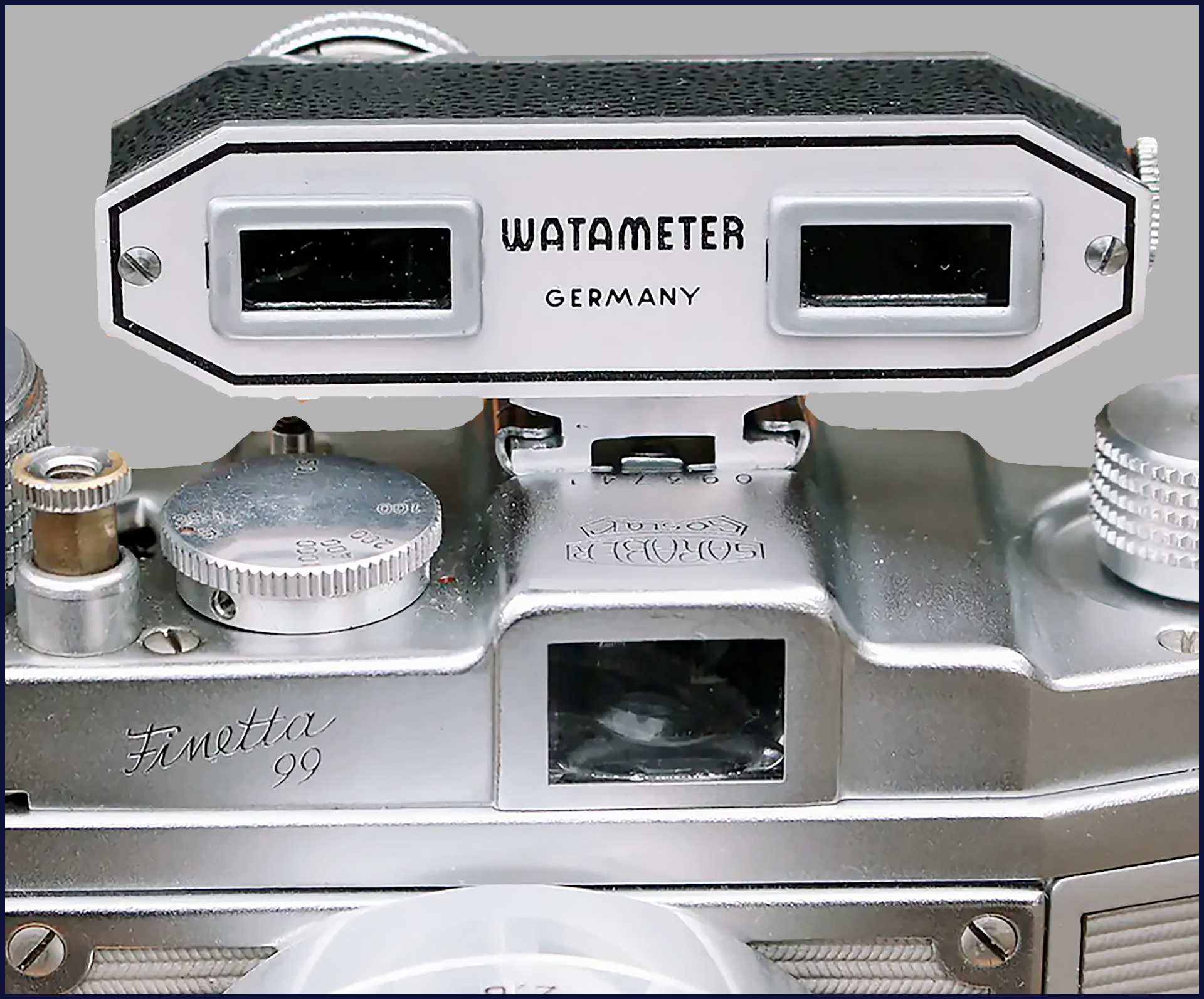
The Watameter Super was the penultimate in a series of auxiliary rangefinders manufactured by Edmund Wateler, Fabrik Opt.-Fotogr. Erzeugnisse in Braunschweig (West Germany). It possesses features almost no other rangefinders of the era had, such as the internal distance scale, which appears on the left-hand side of the viewfinder window. The beauty of this scale is that the user can immediately see the distance without having to lower the camera from the eye.
Another almost unique feature is its macro focusing ability from 50cm down to 30cm; All of these features are wrapped inside a beautiful full metal body with leatherette skin. With its beautiful Art Deco styling and several unique features, it’s truly the Rolls Royce of auxiliary rangefinders.
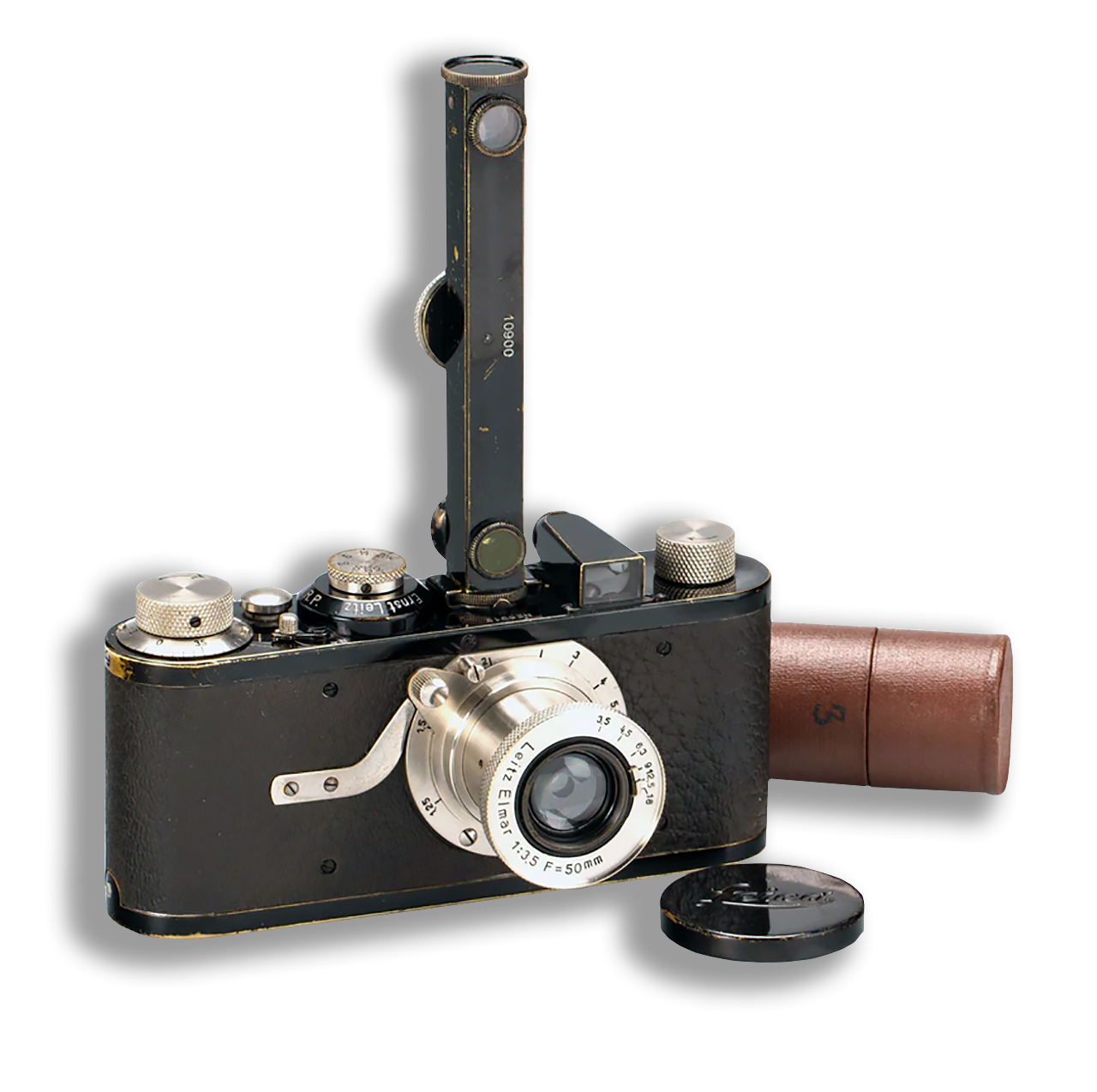
An early Leica I complete with early FODIS rangefinder No. 10900 and original container with two film cassettes.

By far the most common type of rangefinder used in cameras is the double image type. It shows a focusing patch reflected into the center of the viewfinder. When you see two distinct, laterally displaced images within the patch, the image of the subject will be out of focus. To achieve proper focus, you simply turn the ring, wheel, or tab controlling the focusing mechanism to bring both images together until they coincide, and only a single image is visible within the patch.
This type of optical rangefinder works using a beam-splitter, such as a semi-silvered mirror, that reflects some of the light striking it and allows the remainder to pass through. The two separate windows on the front of the camera provide the rangefinder’s primary (stationary) and secondary (moveable) focusing images. The light from the second window is channeled, via a mirror, prism, or lens, that rotates as you turn the focusing ring, causing the secondary focusing image to move laterally, providing a clear visual indication of whether the lens is in focus or not.
The very need for accessory rangefinders and viewfinders was not felt until the advent of the miniature camera, most importantly the small 35mm cameras first introduced by Leitz in the late 1920’s. However, the miniature 35mm camera capable of capturing images with fast shutter speeds and fast lenses also brought the need to more precisely focus the image with a limited depth of field that was often encountered. An additional use for rangefinders was to provide critical focusing for close objects in conjunction with use of auxiliary lenses. These rangefinders not only provided for critical distance measurement, but also the required parallax correction for close focus.
Leitz offered the first widely used and popular accessory rangefinder in 1928 but many other companies followed their lead bringing to market a broad variety over the next 35 years or so.
Most accessory range finders were designed to mount on cameras. Often this meant on a standard cold shoe. However, some range finders were designed with proprietary mounts for a particular camera, and some weren’t design to mount at all, but rather to be carried in a pouch or pocket and used as an independent device (camera mounting is only for convenience; the range finder works just as well independently of the camera, and is in fact less cumbersome).
Rangefinder cameras have been manufactured for the past 100 years. Most models have a built-in range finder (hence their name). However, built-in range finders often only work for one lens or a set of lenses. Thus many manufacturers have manufactured accessory range finders that are essentially universal: instead of being coupled to a lens, they read out the distance, allowing them to be used with any lens. Their utility has ensured that many manufacturers have released range finders over a long period of time, and they are readily available on the used market. This range of choices, however, can be quite overwhelming. A few scattered reviews exist online, but we thought it would be useful to compile a comparison of many of the most common models at the bottom of the page.
Length is important for range finders, for these reasons:
The greater the distance between the two rangefinder measuring windows, the more accurate the meter will be, especially at farther distances. The length thus increases the effective range and precision of the finder.
On the other hand, longer range finders add more bulk and weight to your camera. Longer range finders, especially if they have their cold shoe mount centred on their body, can interfere with other accessories on adjacent mount points. Thus length involves some tradeoffs. Just remember that the cute little rangefinder that fits so well on your camera is sacrificing range and precision for that compact design.

Here’s an example of two models, optimized for different purposes, of Ideal’s range finders: The top model can accurately measure distance out to 300 yards. The bottom can do so only out to 50 feet. But only the bottom one will mount nicely on your camera!
The site http://www.earlyphotography.co.uk/site/accnot.html contains an excellent description of the construction of a number of types of rangefinders. I have taken the liberty of copying the text here in its entirety.
With the increasing use of hand cameras where focusing on a ground glass screen was impossible or inconvenient, separate distance meters came to be used. Originally these were called distance meters or telemeters, the term rangefinder applied to the ‘two position’ optical devices was used a few years later. Some common arrangements are listed below.
Subject Angle (Declination)
These work by aiming a sight at an object, a level or plumb bob will then show the angle the object makes to the horizontal which can be converted into a distance. Popular examples work on a quadrant and plumb bob (Primus, N&G) or built into a view-finder where a level indicates the distance which is marked on the finder lens (Watson).
Standard Subject Size
These are based on the principle that the height of a person or the size of a persons head does not differ greatly. By measuring the size of the image of the person at the camera the approximate distance of that person is given. An early patent was for the legs of a pair of callipers to be adjusted until they matched the subject (person), the callipers were connected to the lens so that making the adjustment focused the lens. A much later implementation was on a Ricoh camera where the view-finder showed a lozenge shape that changed in size as the camera was focused, the lozenge matched the size of a persons head.
Focusing Tube
More or less a camera in tubular form with a lens at one end and a focusing screen at the other, the distance could be read from a scale after focusing.
Optical, ‘Two Positions’
The object is viewed from two positions, the angle subtended by the object gives the distance.
- Woodbury 1914
 Two fixed mirrors are used. The image from one is deflected by a small amount by a lens combination, in the neutral position the deflection produced by the lenses is zero. The positive part of the lens combination remains fixed to the baseboard, the negative lens (and mirrors, camera lens, front standard etc.) move forward and back along the baseboard so altering the deflection produced by the lens combination.
Two fixed mirrors are used. The image from one is deflected by a small amount by a lens combination, in the neutral position the deflection produced by the lenses is zero. The positive part of the lens combination remains fixed to the baseboard, the negative lens (and mirrors, camera lens, front standard etc.) move forward and back along the baseboard so altering the deflection produced by the lens combination. - Swing Mirror
 The subject is viewed by two separated mirrors. One mirror swivels changing the angle of the reflected image. A very popular construction as it is easy to manufacture. Used on the Contax.
The subject is viewed by two separated mirrors. One mirror swivels changing the angle of the reflected image. A very popular construction as it is easy to manufacture. Used on the Contax. - Swing Prism
A prism is used in place of the mirror. Used in the Leica camera. - Rotating Wedge
 Two fixed mirrors are used. In front of one mirror two shallow prisms are arranged, these rotate in opposite directions and so change their deflection and the line of sight. This form requires greater movement to cover the focusing range than the swing prism type, allowing finer movement and greater accuracy. Another advantage is that the prisms need not be located next to the mirror. Used on the Super Ikonta, 1934, where the prisms were mounted on the front standard, a common wheel moved the lens and the prisms.
Two fixed mirrors are used. In front of one mirror two shallow prisms are arranged, these rotate in opposite directions and so change their deflection and the line of sight. This form requires greater movement to cover the focusing range than the swing prism type, allowing finer movement and greater accuracy. Another advantage is that the prisms need not be located next to the mirror. Used on the Super Ikonta, 1934, where the prisms were mounted on the front standard, a common wheel moved the lens and the prisms. - Swing Wedge
 Two fixed prisms (or similar) are used. In front of one there are two cylindrical lenses, in the neutral position there is no deflection. By swinging one of the lenses a prism of varying angle is formed. Used on the Contax 11 camera, 1936. Rather than two air-separated mirrors or prisms, Zeiss favoured a solid glass rhomboid.
Two fixed prisms (or similar) are used. In front of one there are two cylindrical lenses, in the neutral position there is no deflection. By swinging one of the lenses a prism of varying angle is formed. Used on the Contax 11 camera, 1936. Rather than two air-separated mirrors or prisms, Zeiss favoured a solid glass rhomboid. - Bantam Special
 Two fixed prisms are used. In front of one, and attached to the front standard, is a lens that moves laterally. As the camera lens is rotated for focusing a cam moves the rangefinder lens parallel to the rangefinder base. A further development of this was to incorporate the lens behind the prism inside the camera housing. The images are considerably magnified by the rangefinder lens, a similar lens in the path of the secondary image and the eyepiece lenses. The Porro prism close to the eyepiece erects the two images. Developed by Joseph Mihalyi.
Two fixed prisms are used. In front of one, and attached to the front standard, is a lens that moves laterally. As the camera lens is rotated for focusing a cam moves the rangefinder lens parallel to the rangefinder base. A further development of this was to incorporate the lens behind the prism inside the camera housing. The images are considerably magnified by the rangefinder lens, a similar lens in the path of the secondary image and the eyepiece lenses. The Porro prism close to the eyepiece erects the two images. Developed by Joseph Mihalyi. - Leica M2
 The M series used a swivelling lens with the movement coupled to rear of the camera lens. The rangefinder and view-finder were combined in a single window, suspended frames were illuminated from a dedicated window.
The M series used a swivelling lens with the movement coupled to rear of the camera lens. The rangefinder and view-finder were combined in a single window, suspended frames were illuminated from a dedicated window.
Split Field
 The two images are displayed one above the other, as the rangefinder is altered one of the images will move. Typically the mirror or prism in front of the eyepiece has part of its surface clear, the rest is silvered to reflect the ‘second image’. The field may be split horizontally or just a middle section may be silvered.
The two images are displayed one above the other, as the rangefinder is altered one of the images will move. Typically the mirror or prism in front of the eyepiece has part of its surface clear, the rest is silvered to reflect the ‘second image’. The field may be split horizontally or just a middle section may be silvered.
Double Image
Part or all of the mirror is semi-silvered giving a double image. Usually the two images are coloured to increase their contrast, this was either by introducing filters or using a different reflective coating to the mirrors.
Despite the fact that it is very difficult to find detailed data on rangefinders, here is an overview of 36 rangefinders. As mentioned earlier, most of them come from Germany, England and the USA with a few exceptions. This list could easily be expanded to 50 or more copies, but we limit ourselves to the 36 mentioned. In order to be able to make some kind of distinction, the year of introduction is used. In addition, we have selected rangefinders of which we were able to find a more detailed description on the internet.
Thirty images of rangefinders
Most of the rangefinders of this survey come from the sites of mercurycamera.com and earlyphotography.co.uk
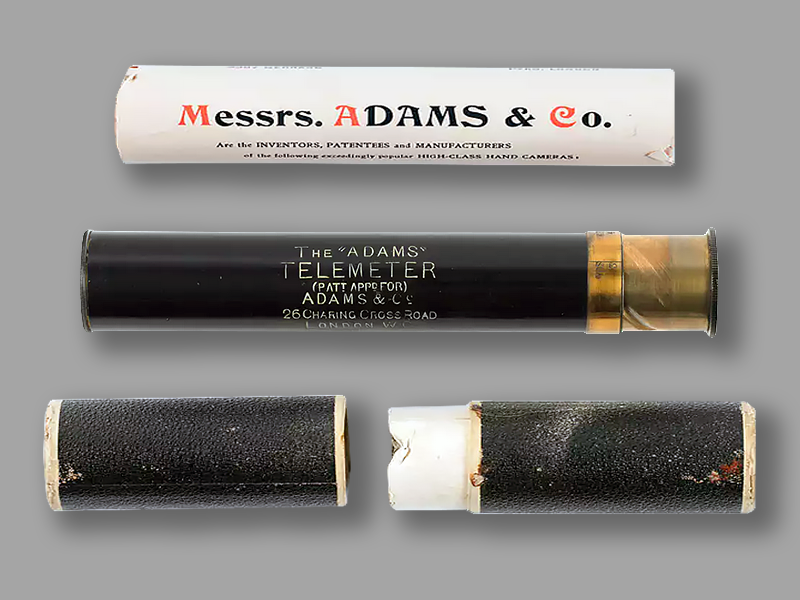
Adams Telemeter
The Adams Telemeter comprises a small telescope; a brass tube inside wooden tube. The inner tube pulls out on an Archimedean thread to focus. The viewer looks through small glass window at one end to larger glass window at other, as the viewer turns the tubes objects will come into focus, inscribed distances on brass ring tell the viewer how far away the object is.
Two distinct versions were produced by Adams & Co., 6 Charing Cross Rd., Londo, England, the first of around 1900 used a ground glass on which the subject was focused, from around 1902 the ground glass was removed leaving a conventional telescope.
- Country: England
- Year: 1900
- Range: 2 – 12 yds
- Known units: yards
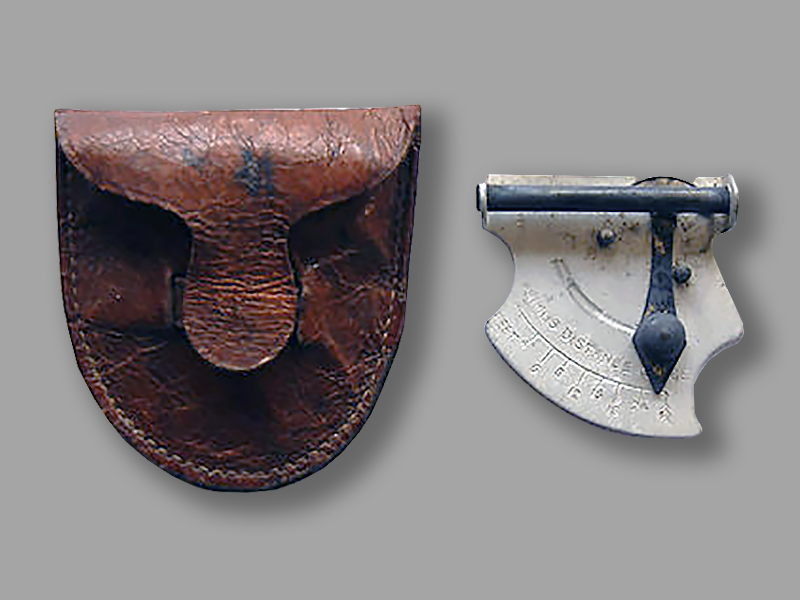
Primus Distance Gauge
The Primus is made by W. Butcher & Sons, London and shows up in the Ensign Photographic Catalogue of 1930. Strangely enough, this gauge bears the same name as the mechanical Primus construction toys that Butcher also marketed. They were the earliest serious rival to Meccano in the field of toy construction sets.
According to the description of the catalogue the instrument serves for calculating distances between camera and objects. Made in aluminium with silvered pendulum. Complete in a leather pouch. The subject is sighted through a tubular finder, a plumb bob moves against a scale showing the distance.
- Country: England
- Year: 1907
- Range: Scale to 4′
- Known units: feet & metres
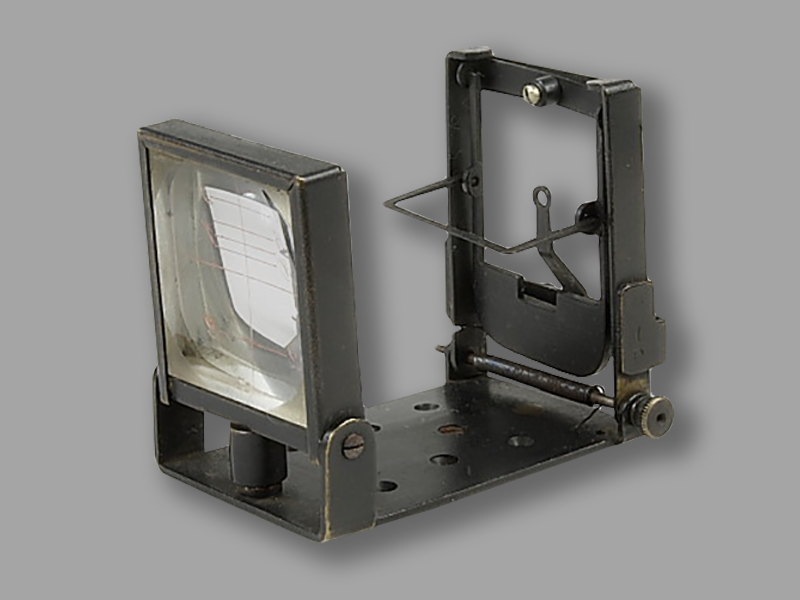
Combined View-finder, Level and Telemeter
This is the first version of a conventional direct-vision finder with a single negative lens and alignment post manufactured by Watson & Sons Ltd, London. At the rear of the finder a frame is hinged so that it remains vertical when the finder is tilted. To this frame a second frame is attached that will remain horizontal. The finder is levelled by aligning the edge of the horizontal frame with a centre line engraved on the lens.
To use as a telemeter the finder is tilted downwards so that the pointer aligns with the centre line on the lens and the base of the subject, the horizontal frame will then point to a value on the distance scale engraved on the lens above the centre line.
- Country: England
- Year: 1907
- Range:
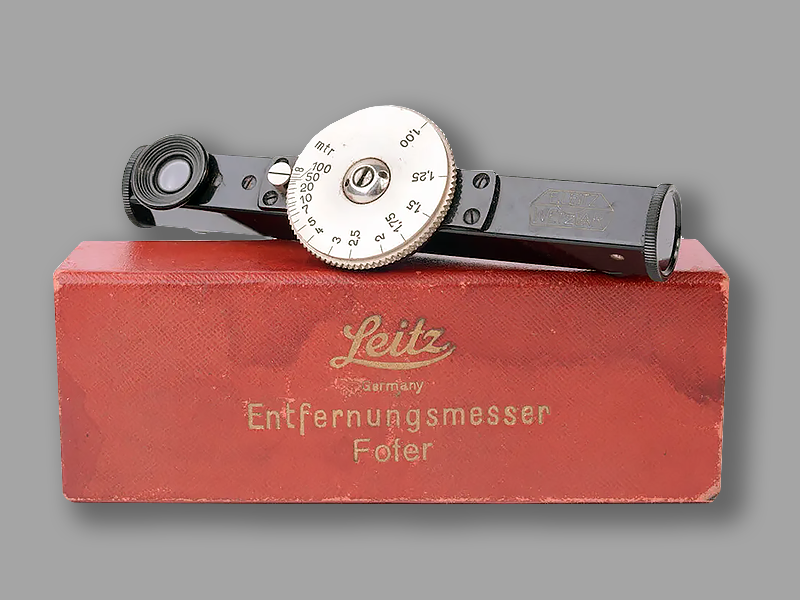
Leitz FOFER rangefinder
The Leitz Fofer Long Base shoe rangefinder was one of the earliest rangefinders on the market. It was manufactured by E. Leitz GmbH, Wetzlar, Germany in 1923 for use with Leica cameras. This uncoupled rangefinder could be used into horizontally or vertically position.
The rangefinder worked according the swing prism principle, with a double image. and a circular secondary image. Scale to 1 meter. Base length of 85 mm (which was quite long).
Black version with large nickel dial wheel. When the rangefinder was introduced in 1923, a small wheel was fitted; this dial wheel became larger in 1930.
- Country: Germany
- Year: 1923
- Range: to 1 meter
- Known units: meter
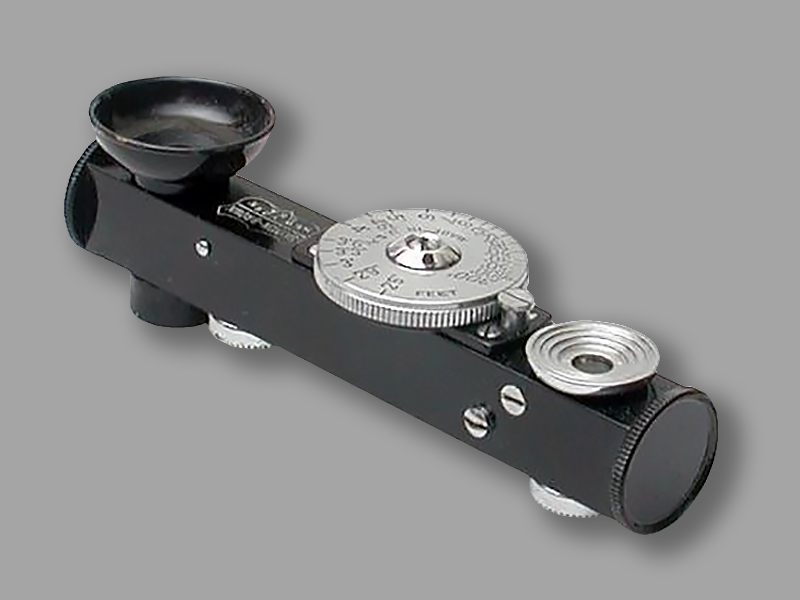
Saymon-Brown Rangefinder
This is one of the earliest accessory range finders, made by Saymon Brown in New York, USA. This is a very high quality range finder, with great precision and accuracy. It is made entirely of metal, and includes threaded front window glass, easy access to internal elements, and multiple adjustment points.
The strange thing about this finder is that it appears to be nearly identical to Leica’s original accessory range finder. Perhaps Saymon-Brown licensed the design from Leica; perhaps it is a clone. Regardless, the Leica version costs a couple of hundred dollars, while the Saymon-Brown is under $30.
- Country: USA
- Year: 1920s
- Range: 2’6” to 300′
- Known Units: Feet (Leica variant: Feet and Meters).
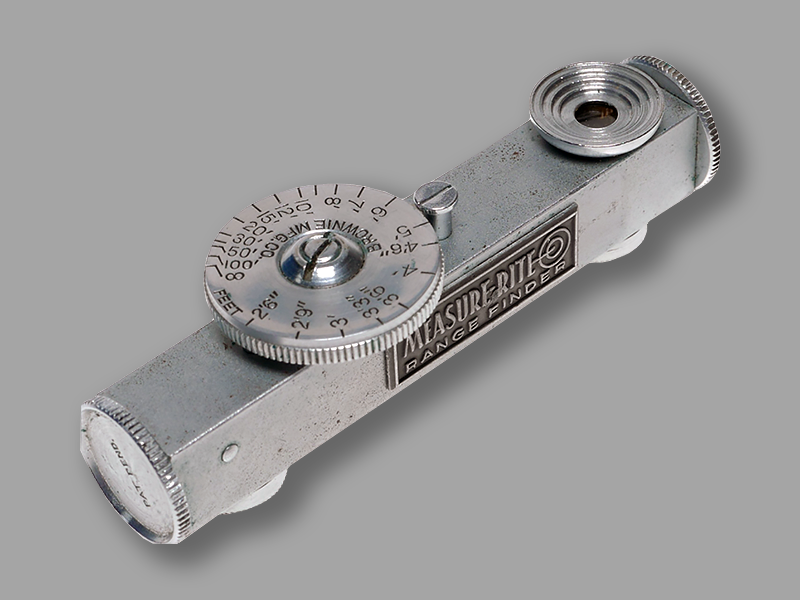
Measure-Rite Rangefinder
An interesting and unusual MEASURE RITE rangefinder, made by the Brownie Manufacturing Company. This retails for about the same price as the Saymon-Brown rangefinder. Viewfinder has a bright yellow hue apart from a spot in the centre for focussing, this makes focussing much easier than many similar range finders.
It uses the same machined components, but has a slightly different (and better) layout, and is gray/silver instead of black. The Measure-Rite, in turn, is almost identical to the “De Jur” by Amsco. It comes with a proprietary mount on the bottom, and discs on either end that fit in cold shoes from 1920s cameras such as the Leica A and I.
- Country: USA
- Year: 1920s
- Range: 2’6” to 300′ – ∞
- Known Units: Feet
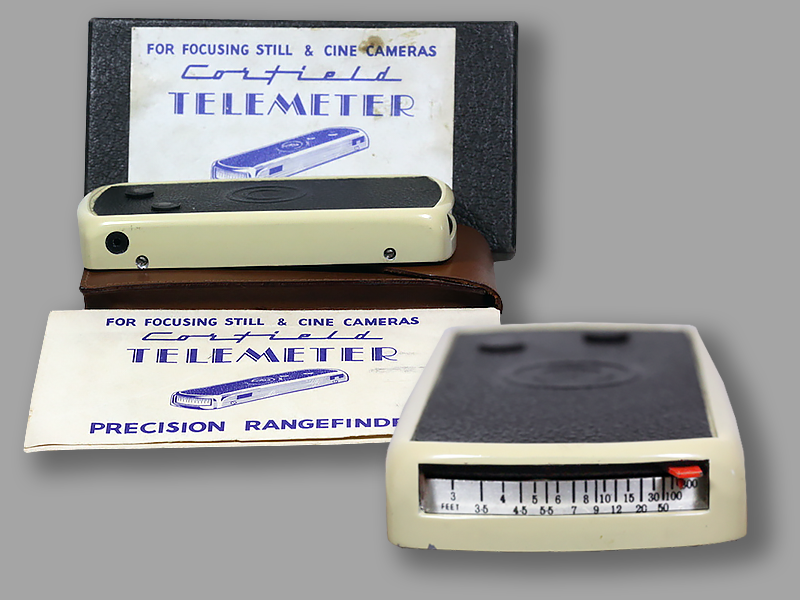
Corfield Telemeter
A curious hand-held split image precision rangefinder called the Corfield Telemeter Rangefinder. It was substantially built around a die-cast, cream stove enamelled, aluminium case with black leatherette panels. The meter was held in place on the user’s hand by a strong elastic strap into which the fingers were inserted.
The two images were aligned by a lever on the right-hand side which moved a red pointer across a distance scale. When the two images aligned, the focus setting could be read from the scale.
The meter is very large compared to those that fit in an accessory shoe. Two rubber plugs can be removed allowing adjustment to the fixed mirror. Two versions were available, one with an imperial scale of 3 to 300ft and another with a metric scale of 1 to 100m. Also produced with an un-painted metal body.
- Country: England
- Year: 1949
- Range: 3 to 300ft/1 to 100m
- Known units: feet & meter
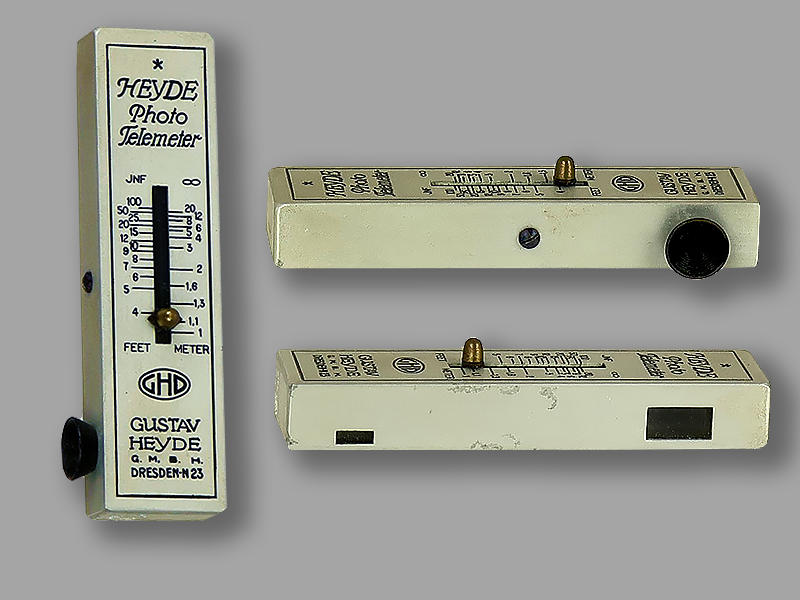
Gustav Heyde Telemeter
This split image Heyde Telemeter from 1925 with a scale to 1 metre and 4’, was manufactured by Gustav Heyde, Dresden, Germany. Hyde was manufacturer of mechanical, opto-mechanical and electronic- mechanical measuring devices. Hyde became a limited company in 1919.
Due to the Russian occupation of Germany the company had to change its names to VEB Optik Feinmess Dresden in 1948. The company became VEB Feinmess Dresden in 1970 when they became part of the VEB Carl Zeiss Jena. Since 1992, they have been part of the Steinmeyer Group.
This early version of the Heyde Telemeter used a slide bar to change the distance. Later improved versions from around 1928, used a wheel while the finish also changed from plain metal to black crackle paint.
- Country: Germany
- Year: < 1926
- Range: to 1 metre and 4′
- Known units: feet & meter
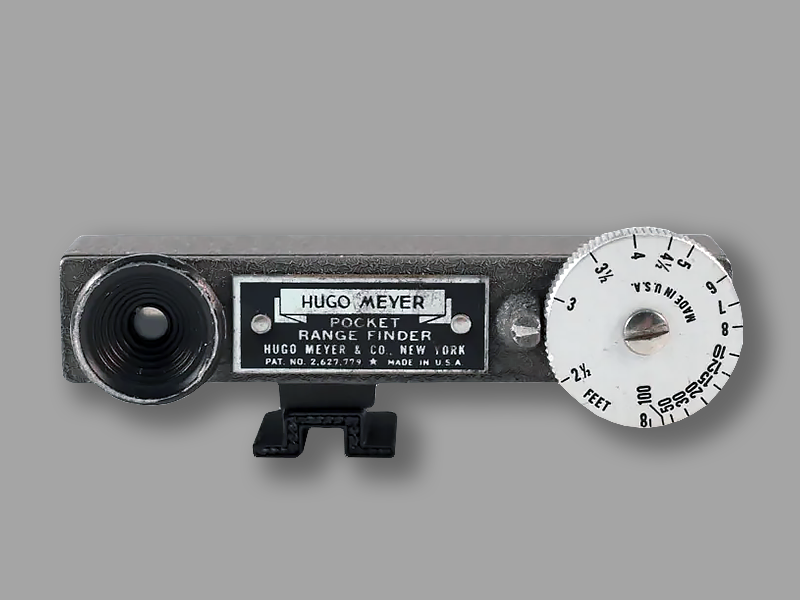
Hugo Meyer Pocket Rangefinder
This device was an early American accessory rangefinder from the Hugo Meyer & Co company, Görlitz, Germany and its American subsidiary company in New York. The company was founded in 1896 by optician Hugo Meyer and businessman Heinrich Schätze.
This rangefinder has an oversized eyepiece and distance dial that are well spread out from each other, making it one of the most comfortable to use of all finders.
Unfortunately, its long length does not translate into extra precision as can be expected, as its measuring windows are not located at the far ends of its body.
Optically, it has better range and precision than a compact finder, but not as much as a standard long rangefinder would have. It will fit on a cold shoe, but not so well.
- Country: USA
- Year: 1940
- Range: 2.5′ to 100′
- Known units: feet
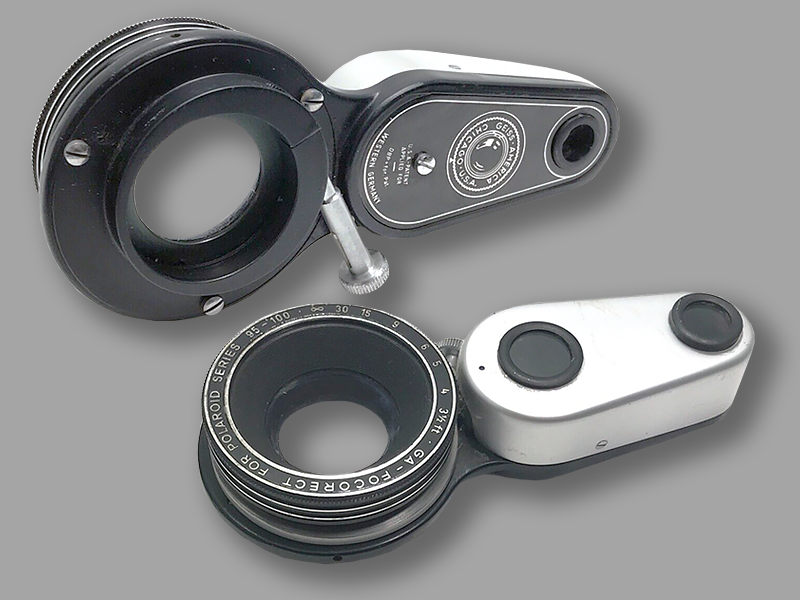
Focorect Model M
This unusual double image device of Hermann Schneider & Co., Hamburg, Germany, combines a rangefinder with a variable focus ‘close-up’ lens. It was made manufactured in the fifties and was distributed in Britain by Johnsons. The Focorect model M cost £18.1.5.
The device is attached (clamps) to the front of the camera lens which has to be set to infinity. Focusing is by altering the separation of the lenses in the Focorect, the movement is coupled to the rangefinder.
In comparison to other rangefinders of that time this device offers a depth of field scale as an extra.
It was produced in two sizes – standard to fit lenses of 27 – 37 mm diameter and model M to fit lenses of 23 – 32 mm diameter.
- Country: Germany
- Year: 1950s
- Range: to 3.5′
- Known units: feet & metres
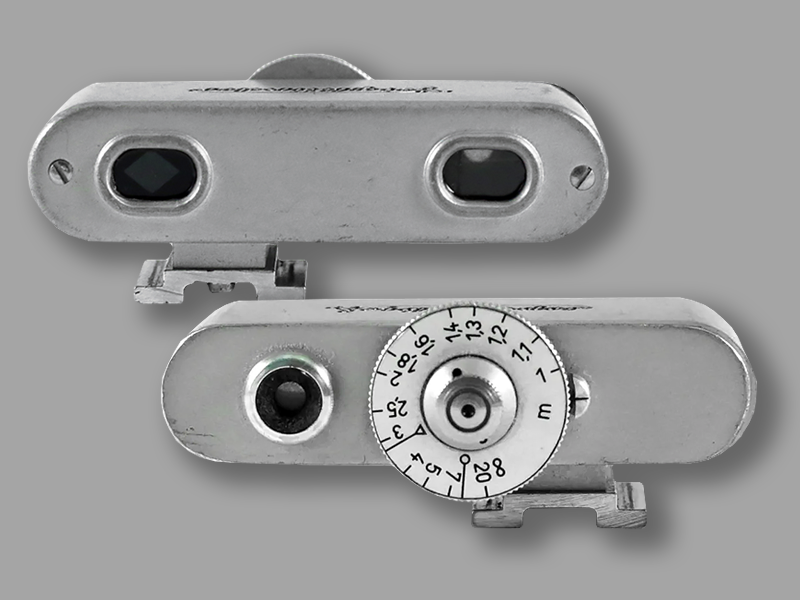
Voigtlander 93/184
This Voigtländer rangefinder was intended for all Voigtländer cameras that did not have a rangefinder. The shapely housing has the typical Voigtlander look, it corresponds with a top view of their cameras .
There were two versions of this rangefinder, which differed in the setting range. The values of the focusing screen correspond to those of the camera lens and can therefore be transferred easily. To measure, the photographer looks through the window above the viewfinder.
This range finder is unique in the fact that the distance dial is located in the middle, with the cold shoe located toward the right side. The short finder, combined with the right-oriented cold shoe, allows it to mount easily on even small cameras without interfering with adjacent cold shoes.
- Country: Germany
- Year: 1956 – 1970
- Range: 1 m – ∞ & 0.8 m – ∞
- Known units: feet & metres
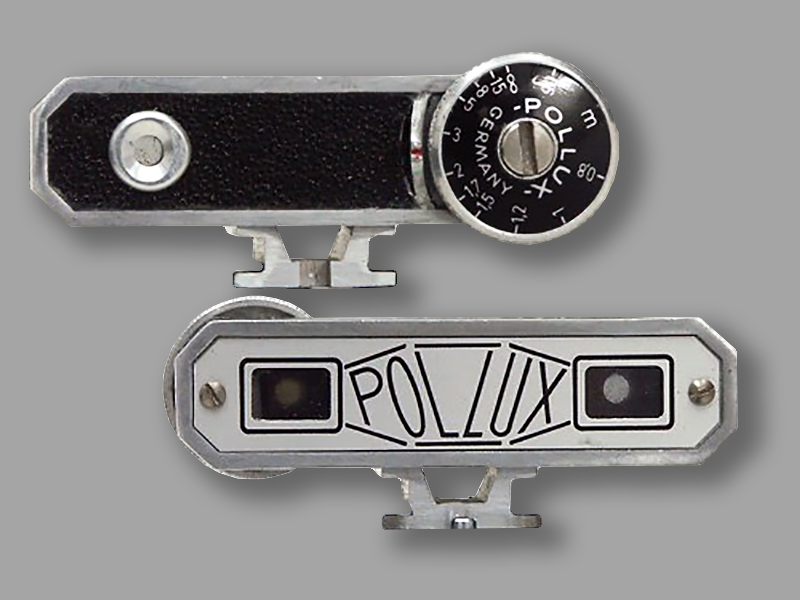
Foitzik Pollux
The Foitzik Pollux is a small, compact rangefinder that clips onto the camera’s accessory shoe. It was manufactured by the Foitzik-Kamerawerke, Trier. The company was founded in 1945 in Lübeck, northern Germany, by machine construction engineer Karl Foitzik. In 1950 the factory reopened in Trier with 20 employees. It was one of the many post-war German camera manufacturers.
Since very few cameras from the 1950s and 60s had a built-in rangefinder, many photographers had problems with focusing. The lenses of 35mm cameras, which are often bright, only had a very shallow depth of field when the aperture was open. So these small rangefinders came in handy; they measured the exact distance to transfer to the lens. A similar Cip rangefinder was also available from Foitzik.
- Country: Germany
- Year: 1951 – 1958
- Range: 0.6 m – ∞
- Known units: metres
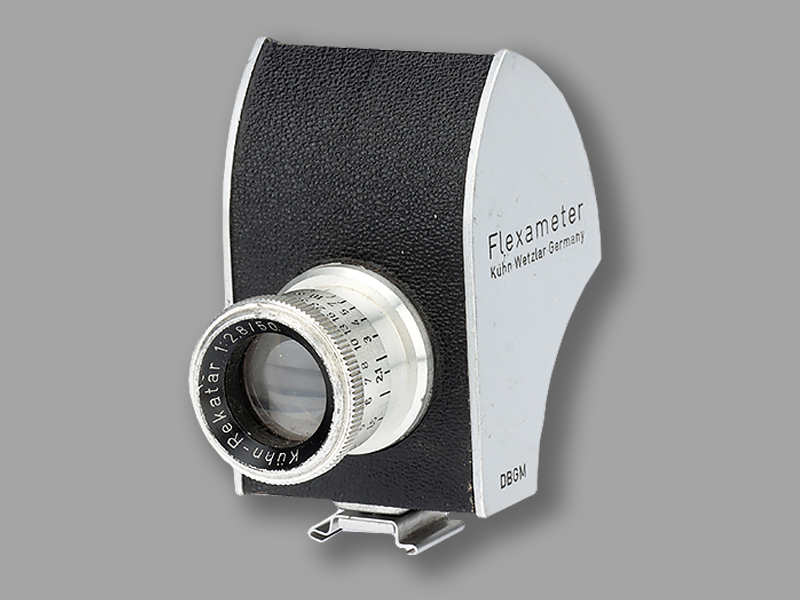
Kühn Flexameter
A rare rangefinder, the Flexameter from Kurt Kühn Apparatebau GmbH, Wetzlar. In the post-war period, viewfinder cameras were mainly used; so a rangefinder was necessary to set the correct distance. This Flexameter turns any camera into an SLR camera with a light shaft viewfinder and viewfinder magnifier. The focusing screen is quite dark, but can still be adjusted quite well.
In addition, you also have the correct image section for a 50 mm lens, interchangeable masks allow for different film formats. The measured distance must be manually transferred to the camera lens. The base of the rangefinder is spring-loaded so that it always sits firmly in the accessory shoe. The parallax of the Flexameter to the camera can be adjusted using two base screws. The Flexameter was offered in the mid-1950s for 28.80 DM.
- Country: Germany
- Year: 1950s
- Range: 1.0 m – ∞
- Known units: metres
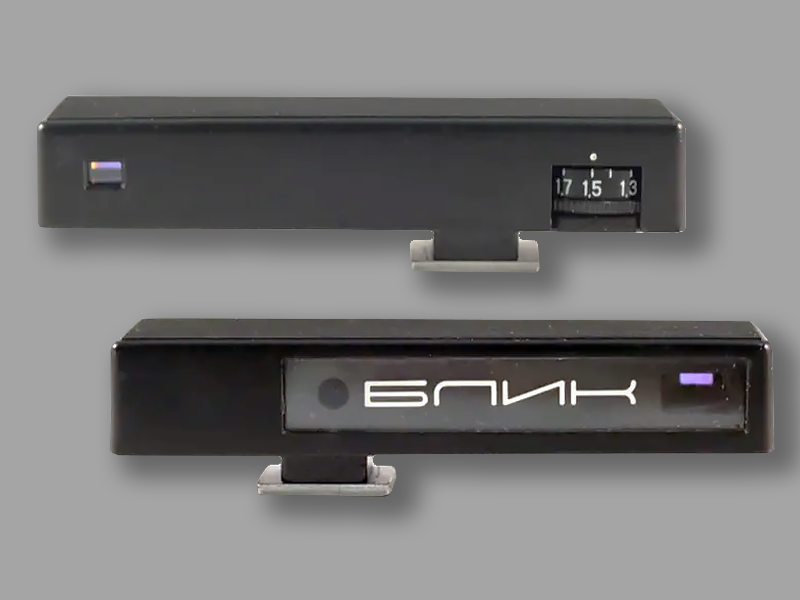
BLIK
The Blik optical accessory rangefinder was produced in large quantities and made by the Soviet firm LOMO in Leningrad (now St. Petersburg) around 1990 and was apparently intended for the later Smena series cameras. The finder has a 50 mm base and measuring range from 1m to infinity, last marked distance is 15m.
The Blik has a pretty loose plastic upper body, but the chassis with a mounting shoe is made of metal. The device is operated by turning a small drum with distance scale at the back of the body, what can be done with the right thumb when the rangefinder is mounted on a camera, although precise adjustment needs some care.
Optical quality of the Blik is simply excellent – viewfinder is bright and contrasty, with circular rangefinder window clearly visibly in the middle even in dim light.
- Country: Russia
- Year: 1990
- Range: 1m – ∞
- Known units: metres
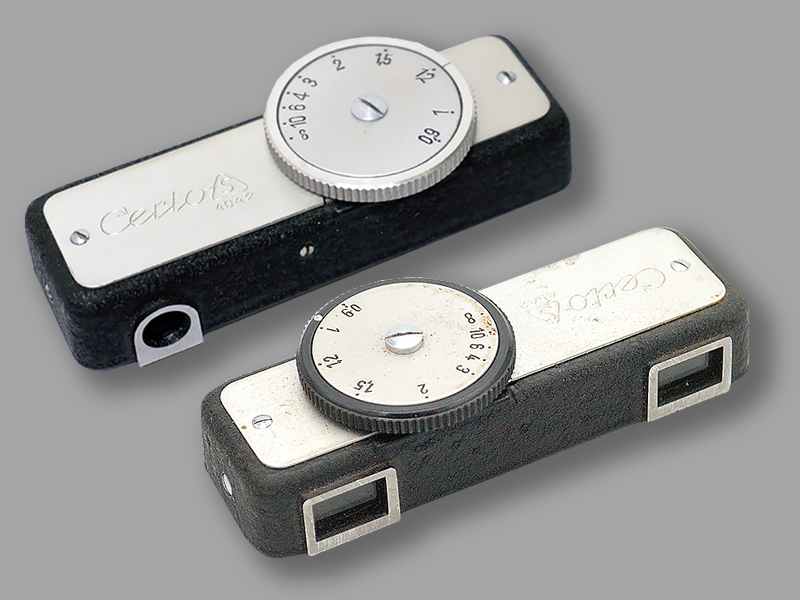
Certos Model A
Attractive rangefinder made of cast metal from the camera manufacturer Certo Camerawerk GmbH.
Base of the Certos rangefinder is 51 mm, while measuring range from 0.9 m (some examples 1 m) to infinity, the last marked distance is 10 m. A pretty convenient adjusting wheel rotating around a clear distance scale is located on top of the body.
The Certos is well built, with a solid metal construction. The rangefinder is very accurate, sadly the optical quality is rather disappointing – the picture from the rangefinder (indirect) window is hardly visible in the viewfinder, making the device usable for very contrasty subjects only.
Five versions of the Certos exist, the models A, B, C, D and N, differing with mounting shoes.
- Country: Germany
- Year: 1951
- Range: (0.9) 1,0 m – ∞
- Known units: metres
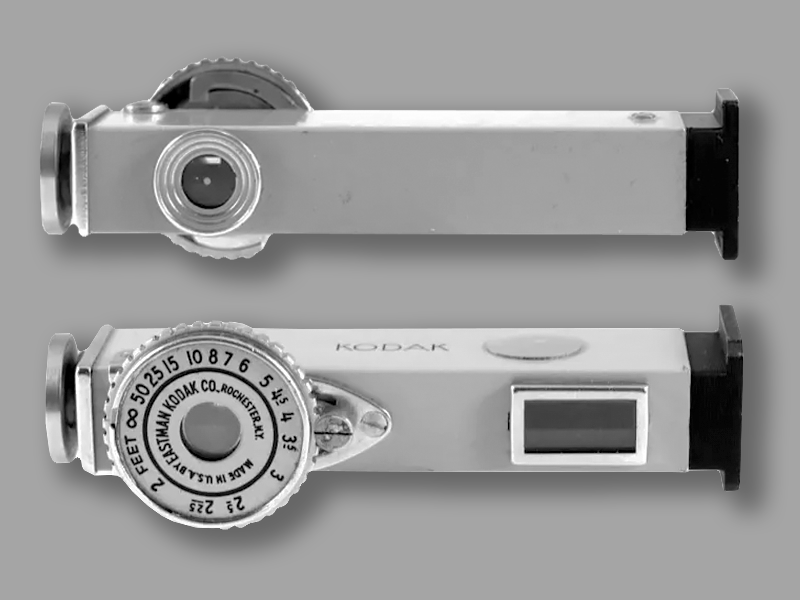
Kodak Service
The Kodak Service rangefinder is an elegant design. One distance scale is on the front and another can be read from inside the finder. Instead of merging overlapping images, this finder merges a split image screen like an SLR; the split image finder gives a larger and brighter image with which to focus. The minimum focussing distance is 2ft. The unit can be mounted vertically in a camera cold shoe.
The single viewfinder on this unit displays, side by side, the split image and an internal distance readout. So one can view the set distance from either in the viewfinder itself or on the front side of the unit/camera, an ability no other range finder has. Personally, I love the aesthetics of this art-deco era device with its clean lines, circular chrome highlights, and fantastic beige color.
- Country: USA
- Year: 1947
- Range: 2′ – 50′
- Known units: feet
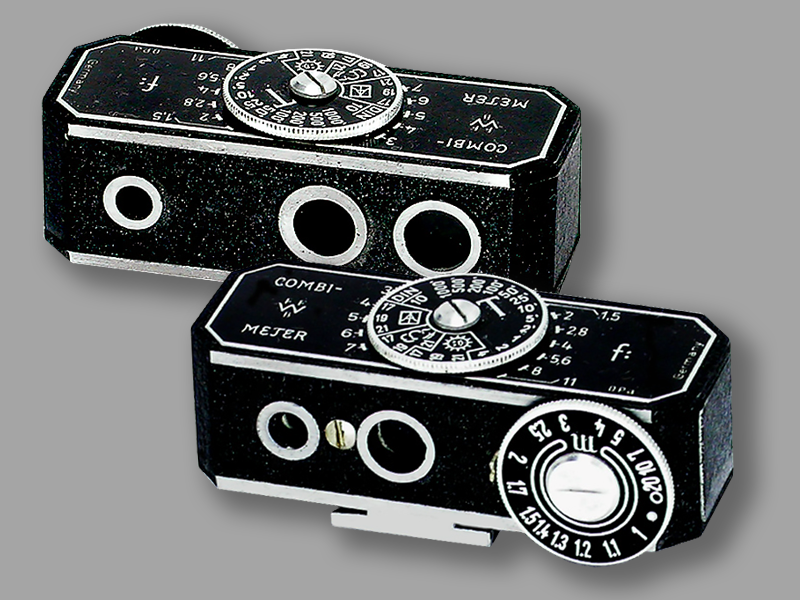
FOGRO Combimeter IIa
One for all: an attachable rangefinder and an optical light meter are combined in this instrument (mid-1950s/Germany). Distances from infinity to one meter. Measuring range from 1/1000 second to four seconds. The base can easily be adapted to any camera. In 1954/55 it cost 18 DM with a case. There was also a light version with a chrome-plated top plate for 21.50 DM (with case) as a Combimeter S. The left eyepiece is for the rangefinder, the right one for the exposure meter.
The manufacturer’s name FFW stands for the photo wholesaler FOGRO KG, Berlin. In addition to the combimeter, flash lights and other accessories were also sold between 1950 and the mid-1960s. FOGRO also manufactured products itself, but it is not known whether the Combimeter was made there. Probably WATA built the Combimeter in Braunschweig.
- Country: Germany
- Year: mid-1950s
- Range: 1m – ∞
- Known units: meter
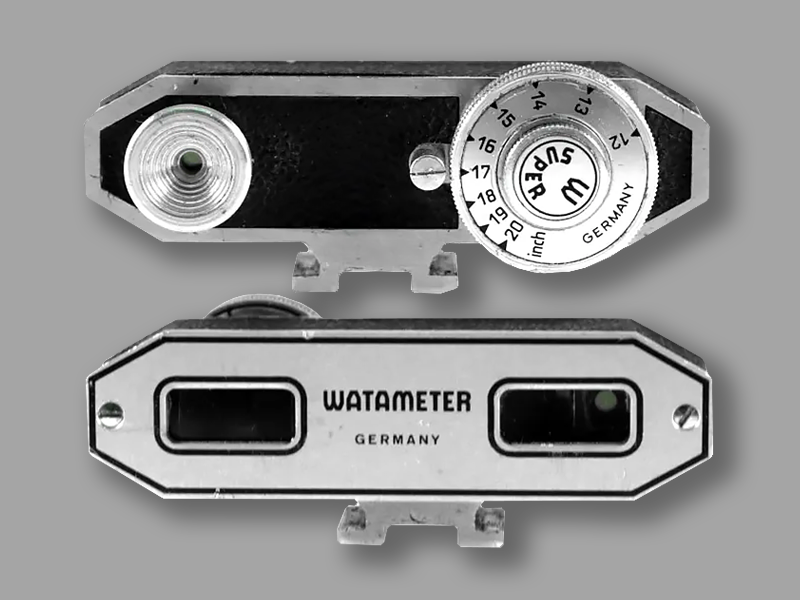
Watameter
Edmund Wateler of Braunschweig Germany made the Cadillac of accessory range finders! Art deco lines, a good viewfinder, a big knurled adjustment knob, extended macro range, and internal readout make this the most full-featured range finder. All metal body with leatherette covering. The Watameter came in three main variants: respectively the Model I, the Model II and the Model Super. A Wattmeter cost 18 DM in 1954/55.
Inside the bright viewfinder window, numbers appear on the lefthand part of the screen, indicating the currently selected distance. Most rangefinders cannot register distance around three feet but the Watameter can! Its dial ranges from 20” down to 12:”. This is certainly closer than any other rangefinder! The eyepiece is made of aluminum and can be removed by unscrewing it.
- Country: Germany
- Year: 1950s
- Range: 12” – 50′/0.55m – ∞.
- Known units: feet & meters
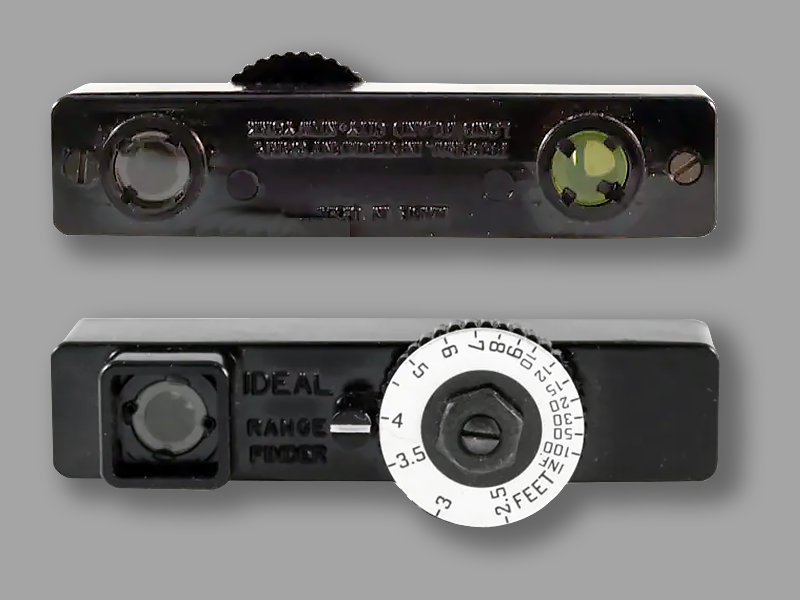
Ideal Range Finder
The Ideal is the poorman’s rangefinder. Just like its Russian counterpart Blik, is its body manufactured from plastic. The rangefinder mechanism consists of two mirrors on a simple channel rod and is moved by a screw. The windows are open, allowing dust to enter the body. It has to be handheld because there is no mounting shoe available.
But to say something less negative about this rangefinder, it has a nice external dial with highly readable black-on-white lettering and it has a long rangefinder base which is quite accurate. The dial is capped off by a rather crude screw and hex nut. It does have a unique square eyepiece that is generous in size and perfect for mounting accessories.
The range on the finder exists almost always in feet, but it is rarely available in meters.
- Country: USA
- Year: 1950s
- Range: 2.5′ – 100′
- Known units: feet, meters
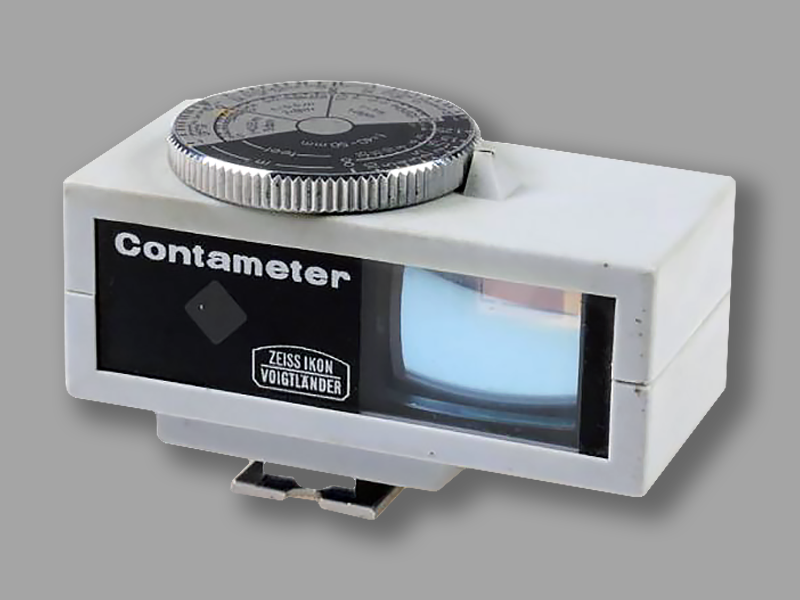
Contax Contameter
Zeiss Ikon always provided its customers with a range of accessories. For the Contax, there was the Contax Contameter. The Contax is a high-quality rangefinder with extended adjustment range for close-ups and with automatic parallax compensation. It was made in the late 60s, because this item is co-branded as Zeiss Ikon/Voigtlander. According to the Zeiss Compendium Carl Zeiss merged Voigtlander into Zeiss Ikon between 1965 and 1968.
The Contameter is very simple to use. The Van Albada viewfinder displays frame lines, while the entire unit pivots up and down when the focusing dial is turned. That helps to compensate for parallax errors. You can use it with lenses from 40mm to 50mm, which covers all of the postwar 35mm cameras and a number of prewar cameras too.
- Country: Germany
- Year: 1968
- Range: 0.33m – ∞
- Known units: feet, meters
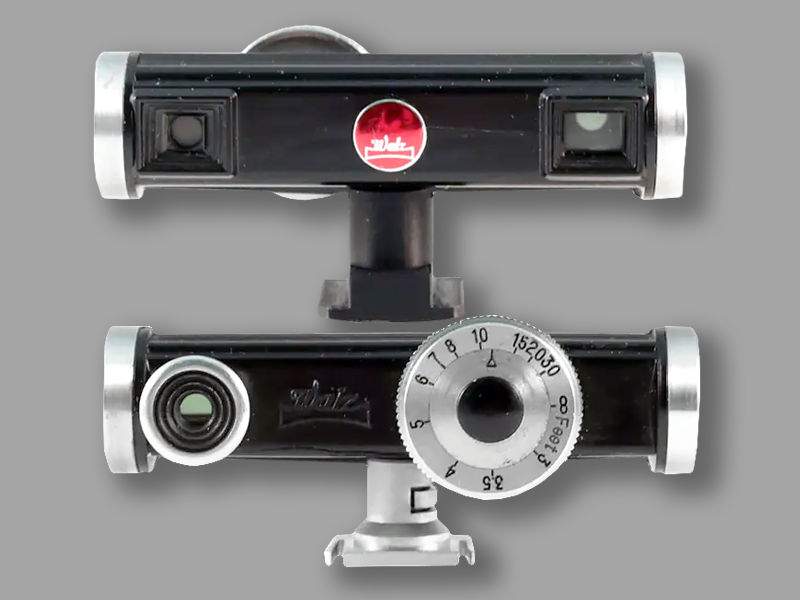
Walz
The Walz is an exemplary range finder that doesn’t offer much in the way of unique features, but gets everything right. Very well made of a combination of metal and plastic, it has great optics, a smart design that maximizes the distance between its measurement windows in a medium sized body, and a removable mount.
The Walz has two generations. The first came in multiple colors, with a plain lettered logo on the viewer’s side and not much on the subject side. The later model comes only in black, and adds a red, raised Walz logo on the subject side, along with more uniquely styled measuring windows. This later model also added, on the right side cap (that threads on and covers the adjustment screw), a little circular chart that converts feet to meters. Overall, a fabulous range finder.
- Country: Japan
- Year:
- Range: 3′ – 60′
- Known units: feet
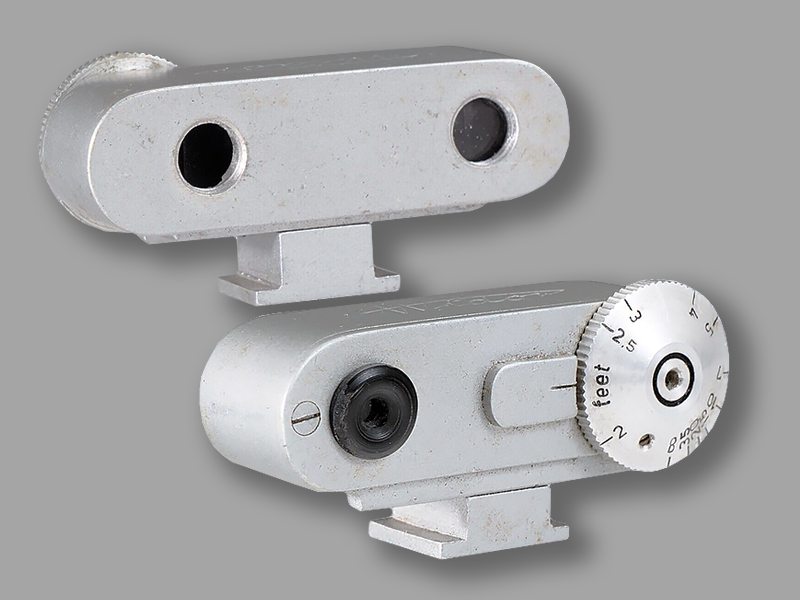
Widor
The Widor Universal Rangefinder produced by Widina in Bad Nauheim Germany is another excellent ultra-compact range finder. (Fun fact: Elvis Presley lived in Bad Nauheim from 1958 to 1960 while in the U.S. Army). Like others in this category, it has reduced range and precision, but compensates by adding some very close distances (2′).
The packaging lists “Germany” while the rangefinder itself is stamped “DRGM” (Deutsche Reich Gebrauchs Muster) and “Germany” and is calibrated in feet, so it is most probably an early post-War model.
It is quite a nice unit and easy to focus. The unit sports both horizontal and vertical rangefinder calibration capabilities. With a baselength of 35mm, the rangefinder is precise enough to focus 50mm f/2 and 90m f/4 lenses.
- Country: Germany
- Year: 1950s
- Range: 2′ – 35′
- Known units: feet, meters
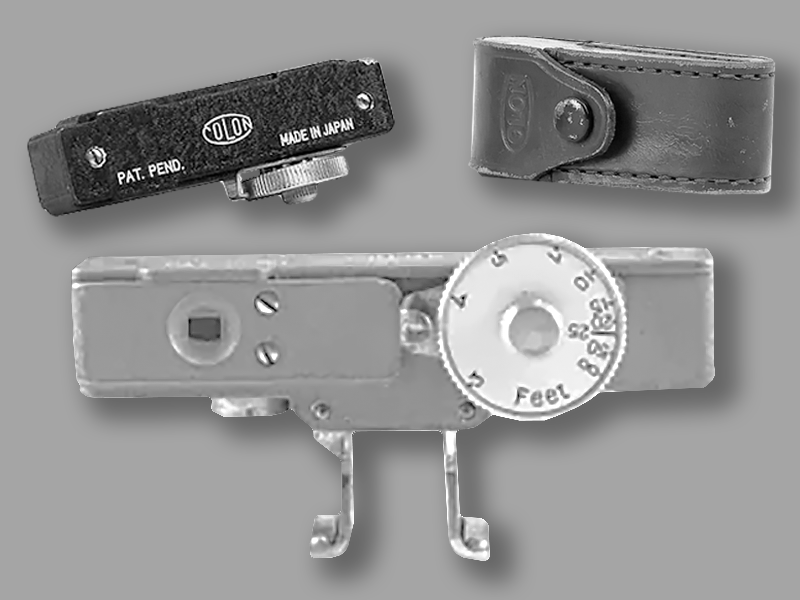
Colon
Despite its unappetizing name, this tiny Japanese range finder is very unique as the most compact in total dimensions unit available. It was manufactured by the Japanese company of the same name: Colon Photographic Industries Limited with its head office established in Setagaya, Tokyo, Japan.
The range finder is svelte on each side, but its secret weapon is a cold shoe mount divided into two sides, each of which folds up into the bottom side of the finder! This makes the rangefinder ultra-compact.
Ultra compact when on a camera, and ultra-ultra-compact when stored off a camera. Perhaps the ultimate travel range finder for tight spaces. It has great styling as well. The downside is of course its reduced precision and range due to its very small size.
- Country: Japan
- Year: early 1960s
- Range: 3′ – 50′
- Known units: feet
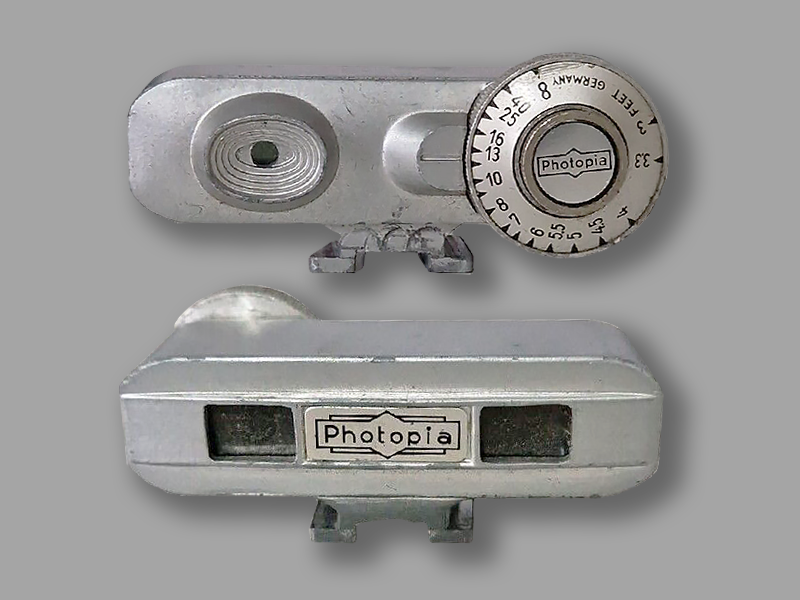
Photopia
Yet another excellent ultra-compact range finder. Though like most, this is made in Germany, it seems to be most popular in the UK. Photopia Ltd. was a photographic distributor based in Newcastle-under-Lyme, Staffordshire, England. The Photopia company developed from an earlier name, Norths Staffs Photographic Services.The company sold cameras and accessories – some of them made and branded for Photopia by various manufacturers such as Vredeborch and King, and others under their original names, such as Wirgin and Regula.
Unlike most others, this rangefinder has a Watameter style large calibration knob. It also has a rather large overlap area, for excellent usability. It works on the coincident principle. This is probably the best of the ultra-compacts.
- Country: Germany
- Year: 1950s
- Range: 3′ – ∞/ 1m – ∞
- Known units: feet, meters
Below are six rangefinders for which I could find little text. However, I do not want to leave them unmentioned in this overview.
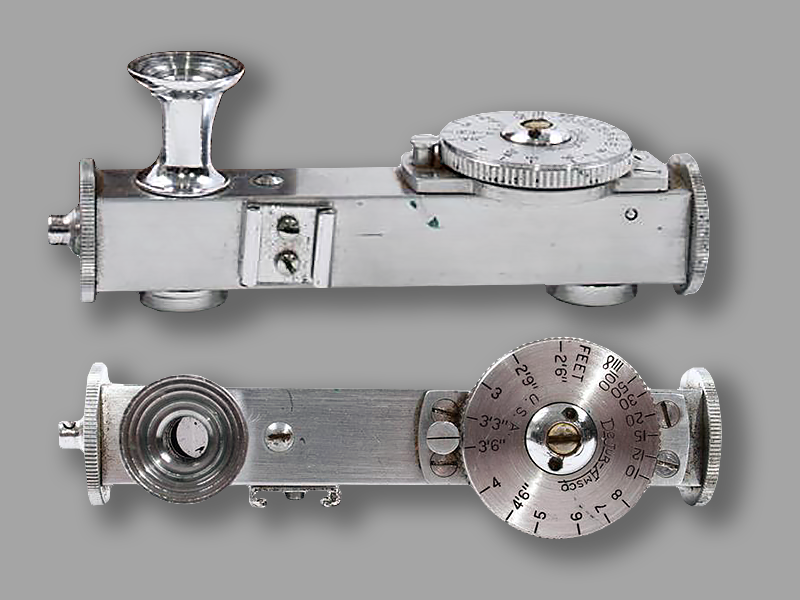
Amsco DeJur rangefinder
The Amsco DeJur rangefinder is accurate and housed in a stainless steel body, which can be mounted vertically in a camera’s hotshoe. It is also an easy rangefinder to handhold because of its size. The minimum focus distance is 2.6 feet.
Modeled after Leica rangefinders, the Amsco is far less expensive than its German cousins.
- Country: USA
- Year:
- Range: 2.6′ – 100′
- Known units: feet
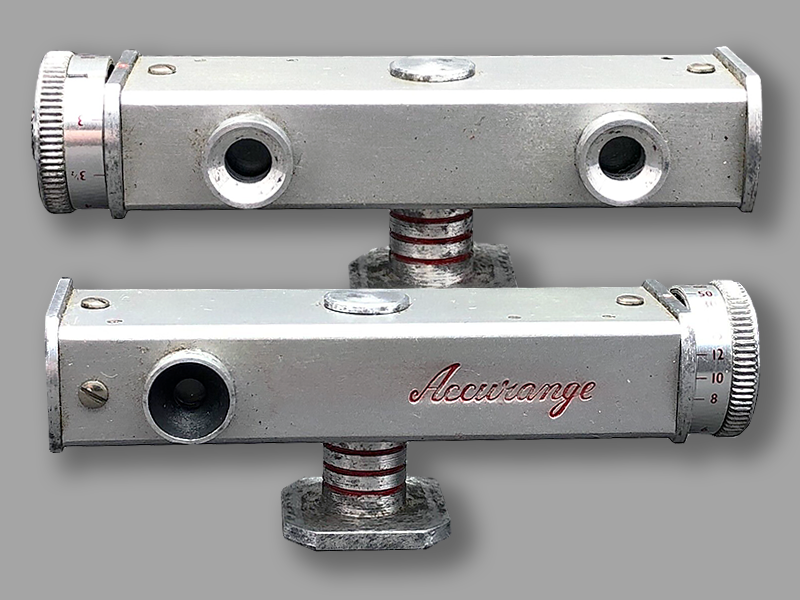
Accurange
Accurange is a cheap rangefinder with an interesting design that has the distance scale at the end of the body. The Accurange dates from about 1960 and would have cost £1 15s 0d. This was a very cheap device of its type – and was sold by “Boots the Chemist”, who were the UKs largest chain of chemists. Boots still sell a small range of photographic gear.
- Country:
- Year: 1960
- Range: 3.0′ – 50′
- Known units: feet
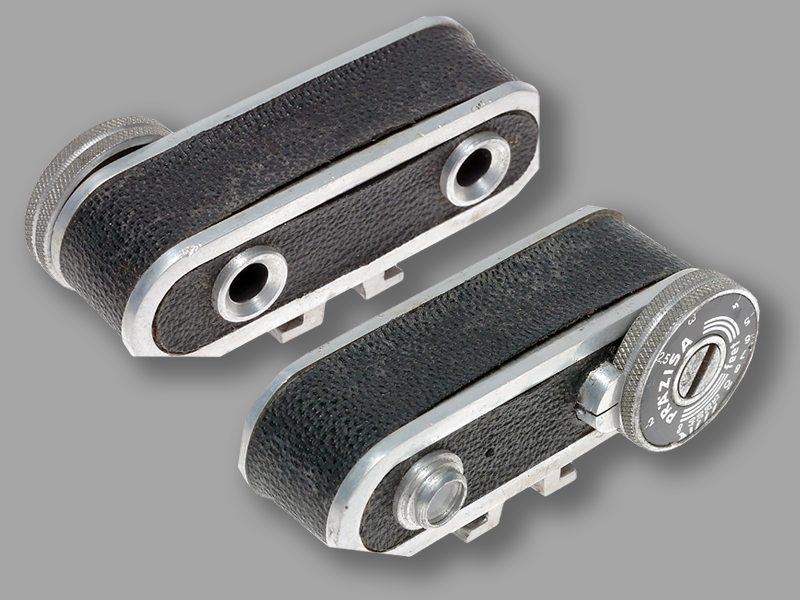
Präzisa
The Präzisa Clip-on rangefinder from the mid-1950s was and is popular in Europe and was sold by the Erwin Enke photo wholesaler (Frankfurt and Stuttgart). It plays a role in the ultra-compact category, with reduced precision and range, but with cute styling and practical mount options. Externally is the Präzisa identical to the Saga-rangefinder.
- Country: Germany
- Year: Ca.1955
- Range: 2.0′ – 40′
- Known units: feet, meters
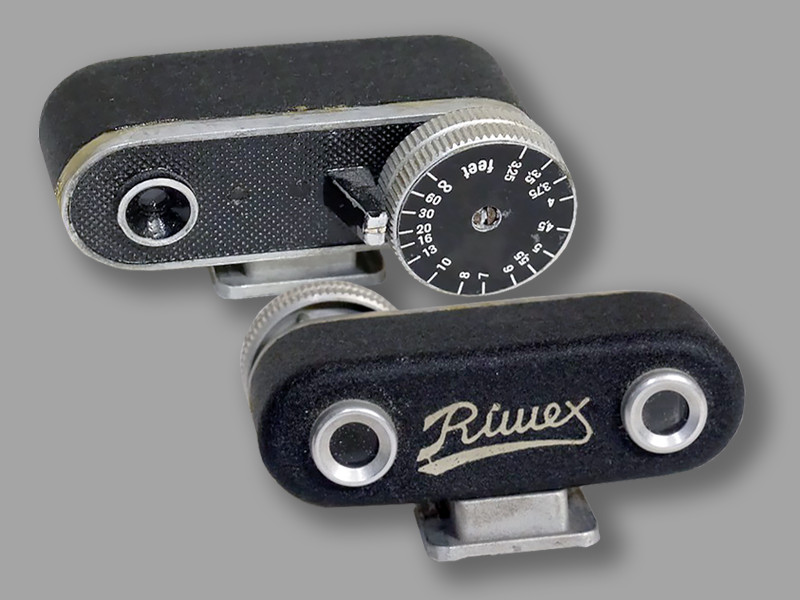
Riwex
Yet another ultra-compact rangefinder, the Riwex. This model was sold under different names, it appears to be the same as the Bodan rangefinder. This finder is really on the extreme side of compact! The distance scale can be in feet or meters with a minimum distance of 3ft or 1 m. The base will limit this rangefinder to normal or wide-angle lenses.
- Country: Germany
- Year:
- Range: 3.25′ – 60′
- Known units: feet
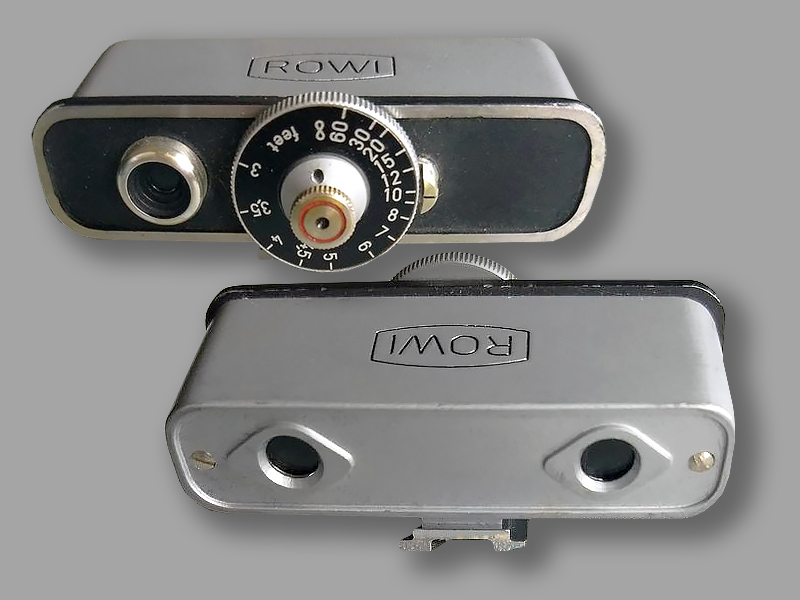
ROWI
The ultra-compact ROWI rangefinder is almost identical to the Voigtlander rangefinder; one is clearly a copy of the other. Only the styling and small details are different.
This range finder is unique in design in that the distance dial is located in the middle of the finder, with the cold shoe located toward the right side.
- Country: Germany
- Year:
- Range: 3′ – 60′
- Known units: feet
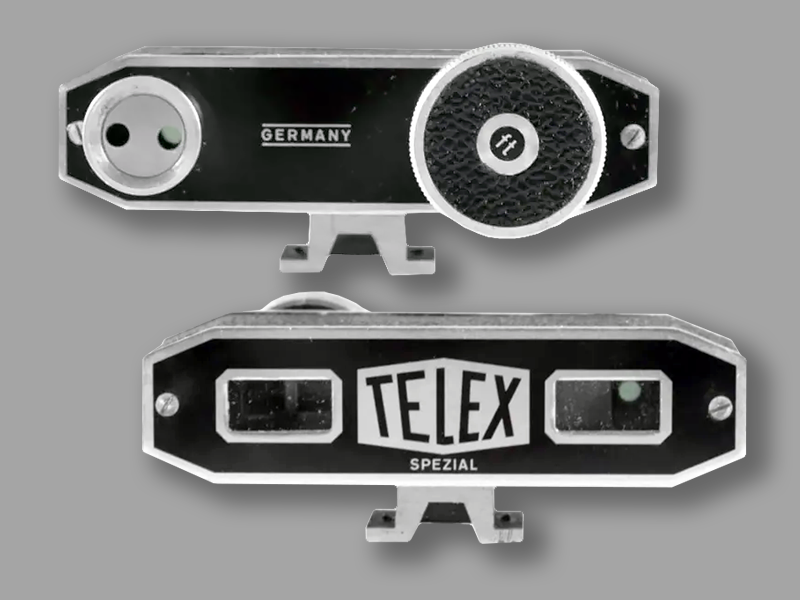
TELEX
The Telex seems to be almost identical to a Watameter. It’s body is exactly the same shape, but slightly thicker. It has the same large knurled dial and the same rectangular windows. But it has a different faceplate and a different viewing window. It has internal readout, but in a separate viewing window, right next to the first, sharing the same eyepiece.
- Country: Germany
- Year:
- Range: 2.5′ to 35′
- Known units: feet, meters

